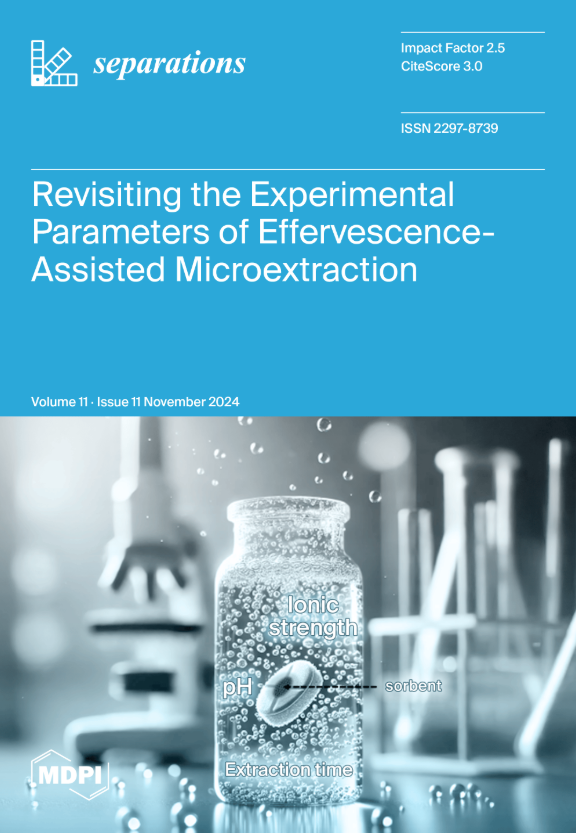Upcycling Textile White Mud to Fabricate MIL-125-Derived Amorphous TiO2@C: Effective Electrocatalyst for Cathodic Reduction of Antibiotics
IF 2.7
4区 工程技术
Q3 CHEMISTRY, ANALYTICAL
引用次数: 0
Abstract
Cathodic reduction is a green and promising remediation strategy for reducing the antibacterial activity of antibiotic contaminants and increasing their biodegradability. However, the lack of cost-effective electrocatalysts has restricted its application. In this study, we upcycled textile white mud by separating 1,4-dicarboxybenzene (BDC) and fabricating MIL-125(Ti)-derived amorphous TiO2@C (TiO2@C-W) as a functional electrocatalyst. The separated BDC from white mud shows lower crystallinity than BDC chemicals, but the resulting TiO2@C-W features a much higher degree of oxygen vacancies and a 25-fold higher specific surface area than that of TiO2@C derived from BDC chemicals. With florfenicol (FLO) as a probe, TiO2@C-W exhibits similar cathodic reductive activity (0.017 min−1) as commercial Pd(3 wt.%)/C (0.018 min−1) does, which was 1.4 and 3.7 times higher than that of oxygen vacancy-engineered TiO2 and TiO2@C, respectively. The as-fabricated TiO2@C-W could not easily remove FLO via the oxygen reduction reaction-based pathway with the applied bias for cathodic reduction. Though the activity of TiO2@C-W undergoes a slight decline with continuous running, more than 80% of 20 mg L−1 FLO can still be reduced in the eighth run. Water chemistry studies suggest that a lower initial solution pH boosts the cathodic reduction process, while common co-existing anions such as Cl−, NO3−, HCO3−, and SO32− show a limited negative impact. Finally, TiO2@C-W shows reductive activity against several representative antibiotics, including nitrofurazone, metronidazole, and levofloxacin, clarifying its potential scope of application for antibiotics (e.g., molecules with structures like furan rings, nitro groups, and halogens). This study couples the upcycling of textile white mud with the remediation of antibiotics by developing functional electrocatalysts, and offers new insights for converting wastes from the printing and dyeing industry into value-added products.利用纺织白泥再循环制造 MIL-125 衍生的无定形 TiO2@C:阴极还原抗生素的有效电催化剂
阴极还原是一种绿色且前景广阔的修复策略,可降低抗生素污染物的抗菌活性并提高其生物降解性。然而,由于缺乏具有成本效益的电催化剂,其应用受到了限制。在这项研究中,我们通过分离 1,4-二羧基苯 (BDC) 来回收利用纺织白泥,并制造出 MIL-125(Ti)衍生的无定形 TiO2@C(TiO2@C-W)作为功能性电催化剂。从白泥中分离出的 BDC 结晶度低于 BDC 化学物质,但与从 BDC 化学物质中提取的 TiO2@C-W 相比,TiO2@C-W 具有更高的氧空位度和 25 倍的比表面积。以氟苯尼考(FLO)为探针,TiO2@C-W 表现出与商用 Pd(3 wt.%)/C(0.018 min-1)相似的阴极还原活性(0.017 min-1),分别是氧空位工程 TiO2 和 TiO2@C 的 1.4 倍和 3.7 倍。在施加阴极还原偏压的情况下,制备的 TiO2@C-W 不容易通过基于氧还原反应的途径去除 FLO。虽然随着连续运行,TiO2@C-W 的活性略有下降,但在第八次运行时,20 mg L-1 FLO 仍有 80% 以上被还原。水化学研究表明,较低的初始溶液 pH 值会促进阴极还原过程,而常见的共存阴离子(如 Cl-、NO3-、HCO3- 和 SO32-)则会产生有限的负面影响。最后,TiO2@C-W 对硝基呋喃唑酮、甲硝唑和左氧氟沙星等几种代表性抗生素具有还原活性,从而明确了其在抗生素(例如具有呋喃环、硝基和卤素等结构的分子)方面的潜在应用范围。这项研究通过开发功能性电催化剂,将纺织白泥的升级再循环与抗生素的修复结合起来,为将印染行业的废物转化为高附加值产品提供了新的见解。
本文章由计算机程序翻译,如有差异,请以英文原文为准。
求助全文
约1分钟内获得全文
求助全文
来源期刊

Separations
Chemistry-Analytical Chemistry
CiteScore
3.00
自引率
15.40%
发文量
342
审稿时长
12 weeks
期刊介绍:
Separations (formerly Chromatography, ISSN 2227-9075, CODEN: CHROBV) provides an advanced forum for separation and purification science and technology in all areas of chemical, biological and physical science. It publishes reviews, regular research papers and communications. Our aim is to encourage scientists to publish their experimental and theoretical results in as much detail as possible. There is no restriction on the length of the papers. The full experimental details must be provided so that the results can be reproduced. There are, in addition, unique features of this journal:
Manuscripts regarding research proposals and research ideas will be particularly welcomed.
Electronic files and software regarding the full details of the calculation and experimental procedure, if unable to be published in a normal way, can be deposited as supplementary material.
Manuscripts concerning summaries and surveys on research cooperation and projects (that are funded by national governments) to give information for a broad field of users.
The scope of the journal includes but is not limited to:
Theory and methodology (theory of separation methods, sample preparation, instrumental and column developments, new separation methodologies, etc.)
Equipment and techniques, novel hyphenated analytical solutions (significantly extended by their combination with spectroscopic methods and in particular, mass spectrometry)
Novel analysis approaches and applications to solve analytical challenges which utilize chromatographic separations as a key step in the overall solution
Computational modelling of separations for the purpose of fundamental understanding and/or chromatographic optimization
 求助内容:
求助内容: 应助结果提醒方式:
应助结果提醒方式:


